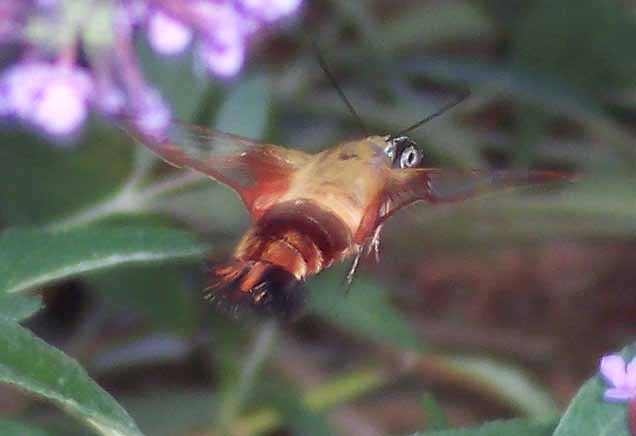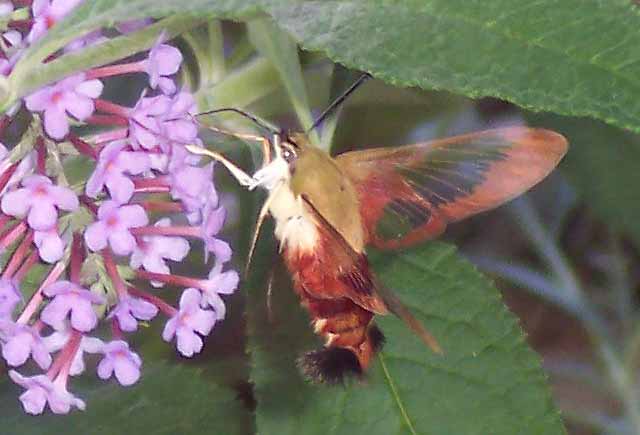Sphinginae subfamily
Sphingini tribe:
 |
Ceratomia amyntor
USGS,
the Elm Sphinx or Four-horned Sphinx
The upperside of the forewing is brown with dark brown and white markings including a white costal area near the wing base,
dark streaks along the veins, and a white spot in the cell.
Larvae feed on Elm (Ulmus), birch (Betula), basswood (Tilia), and
cherry (Prunus). |
 |
This is generally a more southerly species, but it has been recorded
just to the south and west of Livingston County and may be present. The larvae feed in large groups and are much more
spectacular than the moths.
Catalpa is the larval host. |
Ceratomia catalpae E. S. George Reserve, Livingstone Co., July 23, 1977, Harry Dale King.
 |
The upperside of the forewing is pale brownish gray with wavy black and white lines and a black-outlined white cell spot.
|
 |
The upperside of the forewing is dark brown with a dusting of white scales.
Some moths have patches of reddish or yellowish brown on the wings.
|
 |
The upperside of the forewing is gray with heavy black bands. The upperside of the hindwing is brownish gray with no markings.
|
 |
The upperside of the forewing is gray-brown with wavy lines, black dashes, and one or two
small white spots near the center of the costa. |
 |
This large bodied moth flies in tobacco fields and vegetable gardens
(potatoes, tomatoes) and wherever host plants are found. |

|
Manduca sexta
WO, the Carolina Sphinx
The abdomen usually has six pairs of yellow bands, broken across
the back. The sixth set of markings is quite small.
If you grow tomatoes, you have possibly encountered it.
Larvae get very large and can strip a tomato plant.
|

|
Sphinx canadensis
WO,
Sphinx canadensis, the Canadian Sphinx, is not common, and is not often reported anywhere,
but it might possibly be present in Livingston County.
Larval hosts are white ash (Fraxinus americana) and blueberry
(Vaccinium).
|
 |
Sphinx chersis USGS, the Northern Ash
Sphinx or Great Ash Sphinx
The upperside of the forewing is soft dark gray to blue-gray with a series of black dashes,
one of which reaches the wing tip. |
 |
Sphinx drupiferarum
USGS, the Wild Cherry
Sphinx
Forewings, long and slender, are held close to the body when the moth is at rest.
We have them on P.E.I.,
but I do not see them nearly as frequently as I see the other Sphingidae. |
 |
The lower forewings are predominantly brownish-yellow with a fairly
wide dark bar along the inner margin. At rest the wings hug the body,
giving the moth a long slender look.
|
 |
Sphinx luscitiosa
WO,
the Canadian Sphinx or
Clemen's Sphinx
The upperside of the forewing is yellowish gray in males and pale gray with a faint yellow tint in females.
|
 |
If you have blueberries in the woods, then you probably have the
Poecila Sphinx. The forewing is dark gray with diffuse black and gray wavy lines with a series of black dashes ending at the wing tip, and a white cell spot. |
Smerinthini Tribe:
 |
The adults are also highly variable; sometimes wings of an individual may be all one color or may have several colors, ranging from pale to dark brown,
and may have a white or pink tinge.
See the file for the female; she is different. |
 |
The outer margin of the forewing is quite wavy. There is a dark cell spot and a dark oblique line mid wing from the costa almost to the
inner margin. Basic ground colour is pinkish brown. Flight would be June-July. |
 |
Paonias myops USGS,
the Small-eyed Sphinx
This small species is probably widespread and common. This species ranges across North America.
The hindwings have a small blue eyespot ringed with black on a yellow background.
|
 |
Pachysphinx modesta
USGS,
the Modest Sphinx or Poplar Sphinx,
This moth has a large, heavy body, and females can be remarkably plump.
They are a heavy bodied species.
|
 |
Smerinthus cerisyi
USGS, the Cerisyi's
Sphinx or One-eyed Sphinx, Larvae feed on poplars and willows.
Flight would be from late May-July as a single brood.
|
 |
This moth is widely distributed and fairly common, and it is recorded
in Livingston County.
Along the East Coast, it flies from P.E.I. to Florida. |
Macroglossinae subfamily
Dilophonotini Tribe:
 |
Hemaris diffinis
USGS, the Snowberry Clearwing or Bumblebee Moth,
The moth flies along forest edges and in meadows, gardens and
brushy fields. Day-flying adults nectar at lantana, dwarf bush honeysuckle,
snowberry, orange hawkweed, thistles, lilac, Canada violet, etc.
|
See Hemaris comparison
 |
Hemaris thysbe
MR/USGS, the Hummingbird Clearwing
It is not difficult to see why many gardeners would mistake an
Hemaris thysbe moth for a small hummingbird as it hovers,
sipping nectar from flowers through a long feeding tube.
|
Hemaris thysbe, Hartland, September 1, 2005, Mike Ryan
Philampelini Tribe:
 |
This moth is not reported for Livingston,
but should be present. It is fairly often reported
along the coast from southern New Jersey
to central Maine.
Note the differences between this moth and the Pandorus Sphinx. |
 |
If you have Grape or Virginia Creeper nearby, then you probably have
this species. I often get asked to identify larvae from areas where
they have not previously been reported. |
Macroglossini Tribe:
 |
This day flier is widely distributed. If you have Virginia Creeper,
you probably have the Nessus Sphinx. Two bright, distinct, narrow
yellow bands are often visible on the abdomen.
|
 |
They are common in New Jersey and common
here on Prince Edward Island.
You will often see this species listed as Darapsa pholus,
especially in older literature. |
 |
Darapsa myron
USGS, the Virginia Creeper Sphinx or the
Grapevine Sphinx
This moth is recorded on the U.S.G.S. site for Livingston County.
It is widely reported as far north as southern Maine. If you have the
foodplants indicated in the common names, you probably have this
species nearby. |
 |
If you have hydrangea growing near a stream, then you may have the
Hydrangea Sphinx. However, it
probably is uncommon.
|
 |
The moth's outer margin of the forewing is deeply scalloped.
The upperside is light brown with dark brown markings.
There is a small black and white spot near the tip.
The upperside of the hindwing is orange-brown with a dark brown outer margin and median line.
|
 |
Hyles gallii
WO, the Bedstraw Hawk Moth
or Gallium Sphinx
This species is not reported in Livingston, but it may be present.
Some years I see them on P.E.I., some years, I do not.
|
 |
Hyles lineata
USGS, the White-lined Sphinx
Adults usually fly at dusk, during the night, and at dawn, but they
also fly during the day over a wide variety of open habitats
including deserts, suburbs, and gardens. |
 |
This moth is very much under reported on USGS. It is a
rapid day flier so is probably not in too many collections.
Grape is a popular larval host.
|
 |
This moth is much more common to the south and east. It is a strong
migrant, however, and may stray to Livingston.
|
|
|

